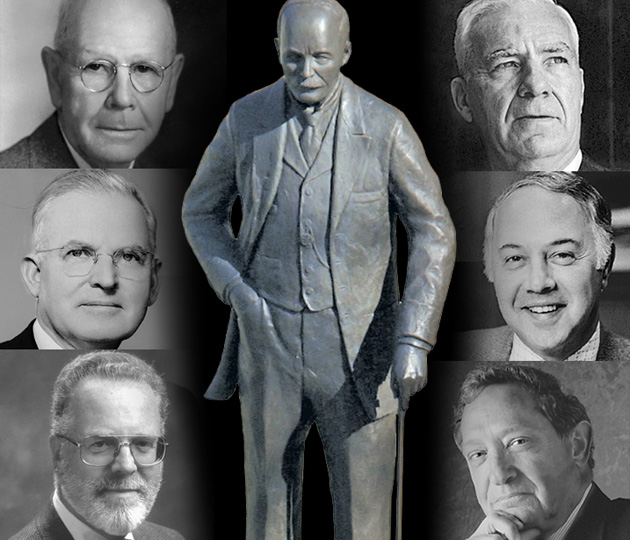Presidential Honor Roll
The top job at SDSU has rarely changed hands in the university's 114-year history.

One hundred fourteen years. Eight presidents. The top job at San Diego State University has rarely changed hands during the institution’s long history, giving each leader ample opportunity to create a unique legacy. Here’s a brief overview.
The founder
Samuel T. Black was founding president of the San Diego Normal School, the state-funded teaching academy that evolved into San Diego State University.
Previously California’s superintendent of public instruction, Black took office in 1897 and served until 1910. He oversaw the new school’s move from cramped quarters over a downtown drug store to a stately new building on Park Boulevard. During his tenure, enrollment grew from 91 to 400.
President Black is remembered for his advocacy and devotion to education, which established a strong foundation and positioned a fledgling institution for future growth.
The expansionist
Edward L. Hardy, the man for whom Hardy Tower, Hardy Avenue and Hardy Elementary School were named, served as president of San Diego State from 1910 to 1935.
Taking a progressive approach to education, Hardy broadened teacher education beyond rote memorization and pedagogy. In large part because of his lobbying efforts, the state legislature in 1921 upgraded San Diego Normal School to San Diego State Teachers College, a four-year, degree-granting institution.
Hardy also pushed for the physical expansion of San Diego State, supervising design and construction of a stunning new California Mission-style campus on Montezuma Mesa, SDSU’s home since 1931. To celebrate the new location, Hardy gave all faculty, staff and students a day off each February to refresh the “S” for State once outlined in painted rocks on nearby Cowles Mountain.
The builder
In 1935, following Hardy’s retirement, Walter R. Hepner became president of San Diego State College, which that same year gained authority to drop the “Teachers” label and offer additional degrees other than education.
A prolific grant writer, Hepner personally sought the funds to add land and facilities to the growing institution. With federal grants from the Depression-era Works Progress Administration (WPA) and New Deal programs, a modern campus began to take shape.
The people’s president
Malcolm A. Love’s personal engagement with the campus community from 1952 to 1971 forged his reputation as “the people’s president.” Walking to campus from his home at 66th Street and Montezuma Road, President Love stopped to say hello and shake hands with every campus person he ncountered. He reportedly knew each faculty and staff member by first name.
Love presided over a time of championship athletics and significant academic growth at San Diego State, which in 1960 became part of the newly formed California State College system. In 1963, he secured President John F. Kennedy as key commencement speaker and awarded him an honorary doctorate.
The research champion
Brage Golding’s five-year tenure as president of San Diego State, from 1972 to 1977, saw the institution officially recognized as a university. A Purdue-educated engineer, Golding focused on building a strong administrative team; hiring new faculty, especially in science and engineering, and strengthening the university’s research foundation.
President Golding’s influence can also be seen in the names of various campus buildings, including Hepner Hall and Hardy Tower, which he designated to honor important figures from campus history. Golding later became president of Kent State University.
Challenging times
The 1978-1996 presidency of theoretical physicist Thomas B. Day was marked by progress in academia but turmoil on campus. In 1980 and again in 1992, Day’s proposed program cuts and faculty/staff layoffs in response to state budget reductions led to loss of morale and—in the early 1990s—campus unrest.
But President Day also played a key role in San Diego State’s development into the major comprehensive university it is today. Through the mid-1990s, SDSU completed long-planned construction projects, and rose to national prominence in terms of academic rankings, faculty honors and alumni accomplishments.
Uniting a campus
San Diego State University’s seventh president, Stephen L. Weber, served from 1996 until his retirement in July 2011. Weber manned the helm during an era of excellence that brought about SDSU’s transformation into a top-tier research university, home to multiple nationally ranked academic programs.
He will no doubt be remembered for his efforts to strengthen ties with the community and for his strong record of increasing grants, contracts and private philanthropy despite economic challenges; addressing community needs through new academic and outreach programs; expanding opportunities for international study; and establishing strong veterans’ programs.
A new era
By all measures, SDSU President Elliot Hirshman has inherited a university whose academic, research and community service credentials are stronger than ever. One of the youngest presidents to serve, Hirshman will lead SDSU into the final phase of its first fundraising campaign.
Sources: “San Diego State University: A History in Word and Image” by
Raymond Starr; Seth Mallios, chair, SDSU Department of Anthropology.



